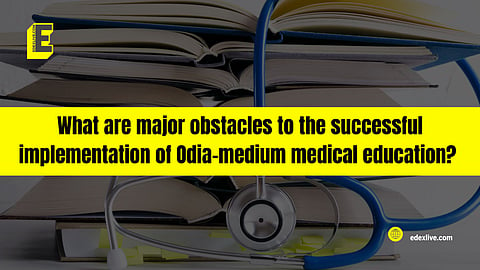

Even as the Government of Odisha has taken a significant step by constituting a committee to explore the possibility of introducing medical education and MBBS textbooks in Odia language, the ambitious endeavour is fraught with numerous challenges.
According to educationists, major obstacles to the successful implementation of Odia-medium medical education lie in proper translation of textbooks, a dearth of qualified faculty proficient in both medical subjects and Odia language and limited takers for the medium.
Translating comprehensive medical textbooks and terminologies from English to Odia is another hurdle.
Medical textbooks are highly specialised and technical, and translating them requires not only a deep understanding of medical science but also the ability to convey complex concepts accurately in Odia. This process will be time-consuming and require skilled translators with expertise in both medical science and the Odia language, they said, stated a report by The New Indian Express.
A retired principal of a medical college said, “The current pool of medical educators in Odisha is predominantly trained in English. Finding or training new faculty members with proficiency in Odia will be too difficult. Besides, before introducing MBBS courses in Odia, the government has to start teaching Plus II Science subjects in the language,” he said.
The response from students to the idea of studying medical education in Odia also has been lukewarm. According to recent data released by the National Testing Agency (NTA), the number of students appearing for the NEET exam in Odia has increased, but the figure is not encouraging.
Lack of interest for medical courses in Odia language
The highest 31,490 students had enrolled to appear for NEET in Odia in 2019 which dropped to 822 in 2020. At least 1,016 students had registered in 2021, 822 in 2022, 988 in 2023 and 1,312 this year. The numbers reflect a low level of interest and demand for medical courses in the Odia language. Lack of enthusiasm among students could lead to under-enrollment in Odia-medium medical courses, which might make the initiative financially and logistically unfeasible, pointed out experts.
Admitting that there are both concerns and possibilities in introducing medical education in Odia, former director of medical education and training Dr CBK Mohanty said it will help those who are from Odia medium to understand medical education better and perform better. “Simultaneously, it will also pose challenges to put things in order and make it implementable. A transitional shift will be better,” he said.
Adapting to the medical curriculum and examination frameworks to accommodate Odia as a medium of education will also be another challenge. The frameworks also need to be aligned with national and international standards.
Chairman of the committee and vice-chancellor of Odisha University of Health Sciences (OUHS) Prof Manash Ranjan Sahoo said the panel will explore all the concerns and possibilities before arriving on a conclusion. “The committee will submit its recommendations in 15 days,” he said.
